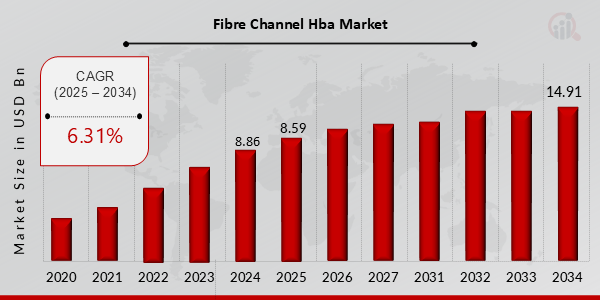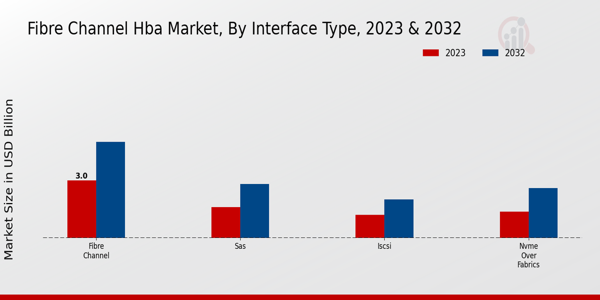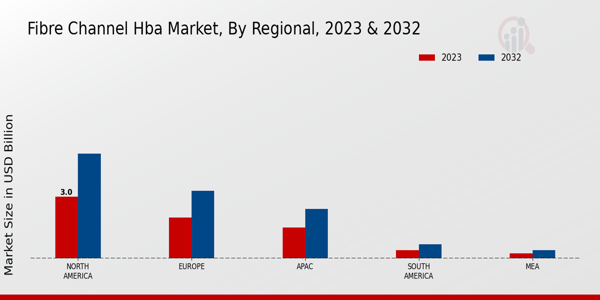Global Fibre Channel HBA Market Overview
Fibre Channel Hba Market Size was estimated at 8.86 (USD Billion) in 2024. The Fibre Channel Hba Market Industry is expected to grow from 8.59 (USD Billion) in 2025 to 14.91 (USD Billion) till 2034, exhibiting a compound annual growth rate (CAGR) of 6.31% during the forecast period (2025 - 2034).
Key Fibre Channel HBA Market Trends Highlighted
The Fibre Channel HBA Market is influenced by several key market drivers that are shaping its growth trajectory. The increasing demand for high-speed data transfer in storage area networks is pushing organizations to adopt Fibre Channel technology. Further, the need for reliable and efficient storage solutions in data centers is driving the adoption of Fibre Channel host bus adapters. As businesses generate more data, the requirement for robust data handling capabilities has intensified, making Fibre Channel HBAs an attractive choice for maintaining speed and reliability.
Additionally, the rise in cloud computing and virtualization trends is prompting organizations to invest in scalable storage solutions, contributing to overall market growth.There are numerous opportunities that can be explored in the Fibre Channel HBA market. The ongoing advancements in technology present prospects for manufacturers to develop innovative and enhanced products. Focus on next-generation Fibre Channel standards can lead to improved performance and compatibility with emerging technologies. Furthermore, the increasing adoption of artificial intelligence and machine learning across various industries necessitates enhanced data processing capabilities, making high-performance storage solutions vital.
This presents manufacturers with an opportunity to tailor their offerings to meet customer needs in these evolving sectors. Recent times have witnessed significant trends within the market, particularly in regard to the growing emphasis on green technology. As sustainability becomes a priority for many businesses, there is a demand for energy-efficient products. Additionally, partnerships and collaborations between technology providers and enterprises are on the rise, aiming to deliver complete solutions rather than standalone products. This trend not only enhances service delivery but also provides a competitive edge in a rapidly evolving market environment. Automation and the integration of smart technologies into storage solutions are also notable trends, reflecting the overall march towards more intelligent, efficient, and flexible storage systems.

Source: Primary Research, Secondary Research, MRFR Database and Analyst Review
Fibre Channel HBA Market Drivers
Increasing Data Center Demand
The growth of the Fibre Channel HBA Market is significantly driven by the increasing demand for data centers across various industries. With the digital transformation of businesses worldwide and the exponential growth in data generation, organizations are continuously seeking efficient and high-speed storage solutions. Fibre Channel Host Bus Adapters (HBAs) are crucial as they provide high-speed, reliable connectivity for storage area networks (SANs).As more businesses migrate to cloud computing and adopt data-intensive applications, the need for robust storage solutions facilitated by Fibre Channel technology becomes essential.
Furthermore, the rising adoption of virtualization technologies enhances the requirement for fast, scalable storage connections that only Fibre Channel HBAs can provide. The integration of advanced technologies such as artificial intelligence (AI) and machine learning (ML) within data centers also requires powerful infrastructure capable of managing large volumes of data efficiently.Therefore, the expansion of data centers globally is an undeniable factor driving the growth of the Fibre Channel HBA Market Industry as organizations strive to enhance their data management capabilities and ensure optimal performance in their operations.
Technological Advancements in Storage Solutions
Technological advancements play a pivotal role in the growth of the Fibre Channel HBA Market Industry. With the rapid evolution of storage technologies, manufacturers are continuously innovating to enhance the performance, speed and efficiency of Fibre Channel HBAs. Enhanced features such as improved data transfer rates, increased scalability, and better compatibility with various storage devices are in constant demand.
Moreover, the integration of advanced functionalities like error correction and smart caching improves data integrity and speed, making Fibre Channel solutions highly preferable for enterprises seeking superior storage solutions.As data storage needs become more complex and demanding, the ongoing technological development within the Fibre Channel HBA sector will ensure sustained market growth and create new opportunities for businesses.
Rising Adoption of High-Performance Computing
The rising adoption of high-performance computing (HPC) solutions across various sectors, including research, healthcare, and finance, is another significant driver for the Fibre Channel HBA Market Industry. HPC requires robust and fast data access processes, and Fibre Channel HBAs cater to these needs with their high-speed data transfer capabilities. As industries increasingly rely on real-time data processing and analytics, the demand for dependable and efficient data storage solutions continues to escalate.Thus, the growth in HPC applications significantly contributes to the Fibre Channel HBA market, pushing the need for advanced storage connectivity solutions to support these high-performance environments.
Fibre Channel HBA Market Segment Insights:
Fibre Channel HBA Market Interface Type Insights
The Fibre Channel HBA Market is experiencing significant growth driven by the increasing demand for high-speed data transfer and storage solutions across various sectors. As of 2023, the overall market valuation stands at 7.15 USD Billion, with the Interface Type segment being a crucial aspect of this market. Within this segment, the Fibre Channel technology is the most prominent, recording a valuation of 3.0 USD Billion in 2023 and projected to rise to 5.0 USD Billion by 2032, establishing its status as a dominant player. The Fibre Channel standard is often preferred in enterprise environments due to its ability to provide reliable, high-performance data transfer, making it essential for organizations that manage large-scale data operations.
Following closely, the SAS interface presents a market valuation of 1.6 USD Billion in 2023, which is expected to expand to 2.8 USD Billion by 2032. SAS, being a popular choice for connecting storage devices, ensures scalability and has a significant foothold among data-centric businesses that rely on long-term performance and durability. The iSCSI segment, valued at 1.2 USD Billion in 2023 with projections reaching 2.0 USD Billion in 2032, offers cost-effective and flexible storage networking solutions that are favored by small to medium-sized enterprises.Its increasing adoption can be attributed to the simplicity and affordability it brings, especially for organizations transitioning to cloud-based environments or virtualization.
Lastly, NVMe over Fabrics has emerged as a notable segment with a starting valuation of 1.35 USD Billion in 2023, anticipated to grow to 2.6 USD Billion in 2032, as it enables high-speed data communication across networks, thus facilitating rapid performance enhancements vital for modern data centers. Overall, the Interface Type segmentation highlights the diversity within the Fibre Channel HBA Market, underscoring each technology's unique attributes and the varied applications that cater to businesses' storage and connectivity needs, contributing to the overall positive trajectory of the market growth.The continued evolution of these technologies will likely present new opportunities for advancement and innovation in data management infrastructure across multiple industries, reinforcing the importance of investing in robust and scalable solutions to meet growing data demands.

Source: Primary Research, Secondary Research, MRFR Database and Analyst Review
Fibre Channel HBA Market Form Factor Insights
This growth can be attributed to the rising data requirements across industries, leading to the adoption of high-performance host bus adapters. In examining the Form Factor segment, it is evident that PCIe Cards dominate due to their flexibility and performance capabilities, making them essential for enterprise-level storage solutions. Meanwhile, Mezzanine Cards are gaining traction because they offer compact designs ideal for densely packed server environments, facilitating efficient space utilization.Integrated solutions also play a critical role, as they provide optimized performance in specific applications, reflecting the diverse needs of modern computing environments.
These insights illustrate the varied applications and strengths of different Form Factor options within the Fibre Channel HBA Market, highlighting their importance in driving market dynamics and catering to evolving technological demands. The significance of market growth is further augmented by trends like the increasing digitization of data and the burgeoning need for enhanced storage capabilities across industries.
Fibre Channel HBA Market Data Rate Insights
As the market continues to evolve, it is evident that higher data rates, such as 16 Gbps and 32 Gbps, are becoming increasingly significant due to their ability to support demanding applications, including data centers and cloud computing. These higher data rates enhance data transfer speeds and improve overall system performance. Meanwhile, 2 Gbps and 4 Gbps connections are still in use, primarily in legacy systems, where organizations are transitioning to faster interfaces.The market is witnessing a shift towards 8 Gbps and above, driven by the increasing need for faster data processing and storage solutions.
Furthermore, the trends in the Fibre Channel HBA Market data suggest that factors such as technological advancements, growing data storage needs, and the proliferation of big data analytics will continue to fuel growth in this segment. However, challenges include the necessity for compatibility across diverse systems and potential cost implications. These aspects highlight the dynamics within the Data Rate segment, which significantly influences the overall Fibre Channel HBA Market revenue and serves as a vital component of the larger market structure.
Fibre Channel HBA Market End Use Insights
Within the End Use segment, the market encompasses several key areas, including Data Centers, Telecommunications, Cloud Service Providers, and Enterprises, each playing a vital role in driving the overall demand. Data Centers are essential for processing large volumes of data and require efficient storage solutions, making them a significant contributor to the market growth. Telecommunications providers depend on reliable and high-performance connections, thereby accentuating the need for advanced Fibre Channel HBAs.Cloud Service Providers are experiencing substantial growth, fueled by the increasing demand for cloud-based services, which necessitate robust connectivity solutions.
Enterprises are also shifting towards more efficient networking hardware, leading to substantial investments in Fibre Channel technology. The combined influence of these sectors demonstrates the Fibre Channel HBA Market's segmentation dynamics, showcasing their importance in shaping market trends and contributing to the overall statistics. As the market expands, opportunities arise in optimizing these technologies to meet evolving industry requirements while addressing the challenges posed by ever-increasing data traffic.
Fibre Channel HBA Market Regional Insights
The Fibre Channel HBA Market revenue reflects a robust segmentation across various regions, highlighting diverse growth dynamics. In 2023, North America was valued at 3.0 USD Billion, making it the dominant region with a majority holding in the market, driven by strong adoption of advanced data center technologies. Europe follows with a valuation of 2.0 USD Billion, benefiting from ongoing digital transformation across numerous industries. The APAC region, valued at 1.5 USD Billion in 2023, is witnessing significant growth due to rapid industrialization and investment in IT infrastructure.
South America and MEA are comparatively smaller markets, valued at 0.4 USD Billion and 0.25 USD Billion, respectively, in 2023, yet they offer opportunities for growth as organizations in these regions pursue modernization strategies. Collectively, these regional values contribute to an overall market that is on a trajectory for growth, underpinned by trends such as increased data storage needs and the evolution of cloud technologies. The Fibre Channel HBA Market industry continues to evolve, influenced by regional demands and technological advancements, suggesting promising possibilities in the coming years.

Source: Primary Research, Secondary Research, MRFR Database and Analyst Review
Fibre Channel HBA Market Key Players and Competitive Insights:
The Fibre Channel HBA Market is characterized by a dynamic and competitive landscape, with numerous players vying for market share by offering innovative solutions and technologies. As organizations increasingly rely on high-speed data transfer and efficient storage networking, the demand for Fibre Channel Host Bus Adapters (HBAs) continues to grow. This market is influenced by various factors, including the need for improved data management, advancements in networking technology, and the ongoing transition toward digitalization across diverse industries.
The competitive insights within this industry reveal trends related to product launches, partnerships, and technological advancements as companies seek to establish a strong foothold and cater to evolving customer needs in data storage and networking solutions.Hewlett Packard Enterprise has established itself as a significant player in the Fibre Channel HBA Market, leveraging its extensive expertise in IT infrastructure and storage solutions. The company's strength lies in its comprehensive portfolio of high-performance Fibre Channel HBAs designed to enhance data transfer speeds and optimize storage networks. With a focus on innovation, Hewlett Packard Enterprise continuously develops and enhances its products, ensuring compatibility with a wide range of systems and leading-edge technologies.
Furthermore, the company provides robust support and services to its customers, positioning itself as a trusted partner in the deployment of Fibre Channel solutions. This commitment to quality and performance has solidified Hewlett Packard Enterprise's market presence and reputation among enterprises seeking reliable and high-speed data connectivity options.NETGEAR has also made notable contributions to the Fibre Channel HBA Market, focusing on providing high-quality and performance-driven solutions tailored to the needs of businesses. The company emphasizes the integration of advanced technologies into its Fibre Channel products, which facilitate seamless connectivity and data transmission in high-demand environments.
NETGEAR's strengths lie in its ability to deliver cost-effective solutions without compromising performance standards, making it an attractive option for small to medium-sized enterprises looking to enhance their data infrastructure. The company's commitment to customer-centric design and user-friendly interfaces further boosts its appeal in the market. Additionally, NETGEAR's proactive approach to addressing technological advancements and market trends enables it to stay relevant and competitive, ensuring that it meets the evolving demands of its customer base.
Key Companies in the Fibre Channel HBA Market Include:
- Hewlett Packard Enterprise
- NETGEAR
- QLogic
- Broadcom
- Lightbits Labs
- Western Digital
- IBM
- Samsung Electronics
- Fujitsu
- Dell Technologies
- Oracle
- MikroTik
- Cisco Systems
- Infinidat
- NetApp
Fibre Channel HBA Market Industry Developments
The Fibre Channel HBA Market has recently seen significant developments, particularly with companies like Hewlett Packard Enterprise, NETGEAR, and QLogic enhancing their product offerings to meet growing data center demands. Broadcom has been actively investing in R&D to improve its HBA technologies, while Lightbits Labs is gaining attention for its innovative storage solutions. Western Digital and IBM are focusing on integrating Fibre Channel HBAs with cloud services, which is expected to drive growth. Dell Technologies has launched new solutions that support high-speed data transfers, linking their enterprise offerings closely with Fibre Channel technology. In terms of mergers and acquisitions, there have been no publicly known deals related to the specified companies in this sector recently.
However, growth in market valuations has been observed, resulting from rising demand for efficient data management and transfer technologies across industries, thereby impacting the overall Fibre Channel HBA landscape positively. Companies such as Samsung Electronics and Cisco Systems continue to evolve their strategies, emphasizing partnerships, to enhance the efficacy of Fibre Channel integrations in enterprise environments. As storage needs escalate, the competition among these industry leaders is expected to intensify, influencing market dynamics further.
Fibre Channel HBA Market Segmentation Insights
-
Fibre Channel HBA Market Interface Type Outlook
- Fibre Channel
- SAS
- iSCSI
- NVMe over Fabrics
-
Fibre Channel HBA Market Form Factor Outlook
- PCIe Card
- Mezzanine Card
- Integrated
-
Fibre Channel HBA Market Data Rate Outlook
- 2 Gbps
- 4 Gbps
- 8 Gbps
- 16 Gbps
- 32 Gbps
-
Fibre Channel HBA Market End Use Outlook
- Data Centers
- Telecommunications
- Cloud Service Providers
- Enterprises
-
Fibre Channel HBA Market Regional Outlook
-
North America
-
Europe
-
South America
-
Asia Pacific
-
Middle East and Africa
| Report Attribute/Metric |
Details |
|
Market Size 2024
|
USD 8.86 Billion
|
|
Market Size 2025
|
USD 8.59 Billion
|
|
Market Size 2034
|
USD 14.91 Billion
|
|
Compound Annual Growth Rate (CAGR)
|
6.31% (2025-2034)
|
|
Base Year
|
2024
|
|
Market Forecast Period
|
2025-2034
|
|
Historical Data
|
2020-2023
|
| Market Forecast Units |
USD Billion |
| Key Companies Profiled |
Hewlett Packard Enterprise, NETGEAR, QLogic, Broadcom, Lightbits Labs, Western Digital, IBM, Samsung Electronics, Fujitsu, Dell Technologies, Oracle, MikroTik, Cisco Systems, Infinidat, NetApp |
| Segments Covered |
Interface Type, Form Factor, Data Rate, End Use, Regional |
| Key Market Opportunities |
Increasing cloud adoption,Rising data center expansion,Demand for high-speed connectivity,Growth in virtualization technology,Expansion of IoT applications |
| Key Market Dynamics |
Rising data center demands, Increasing cloud adoption, Growing need for high-speed connectivity, Advancements in storage technologies, Escalating enterprise workloads |
| Countries Covered |
North America, Europe, APAC, South America, MEA |
Frequently Asked Questions (FAQ) :
The Fibre Channel HBA Market is expected to be valued at 14.91 USD Billion by 2034.
The projected CAGR for the Fibre Channel HBA Market is 6.31% from 2025 to 2034.
North America is expected to have the largest market size at 5.1 USD Billion by 2032.
The market size for Fibre Channel is expected to reach 5.0 USD Billion by 2032.
Key players in the Fibre Channel HBA Market include Hewlett Packard Enterprise, NETGEAR, QLogic, and Broadcom.
The SAS segment is expected to reach 2.8 USD Billion by 2032.
The APAC region is expected to contribute 2.4 USD Billion to the Fibre Channel HBA Market by 2032.
The NVMe over Fabrics segment is expected to reach 2.6 USD Billion by 2032.
Major growth drivers include increasing data storage needs and advancements in network technologies.
The anticipated market size for the iSCSI segment is expected to be 2.0 USD Billion by 2032.

















